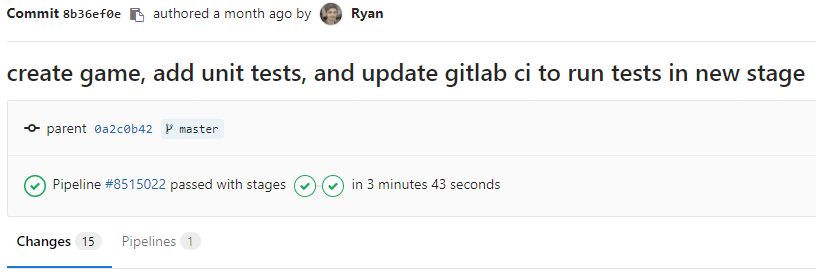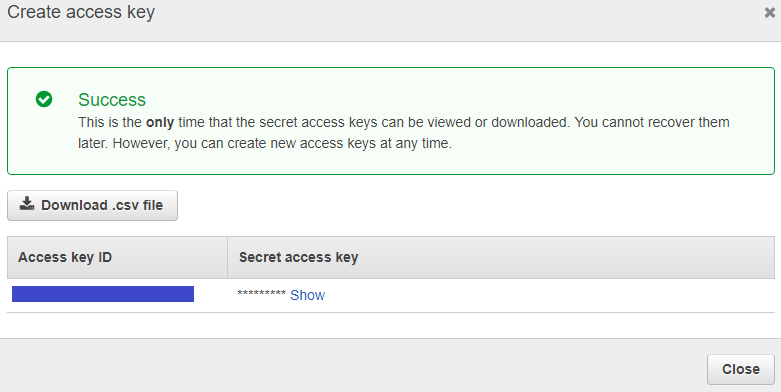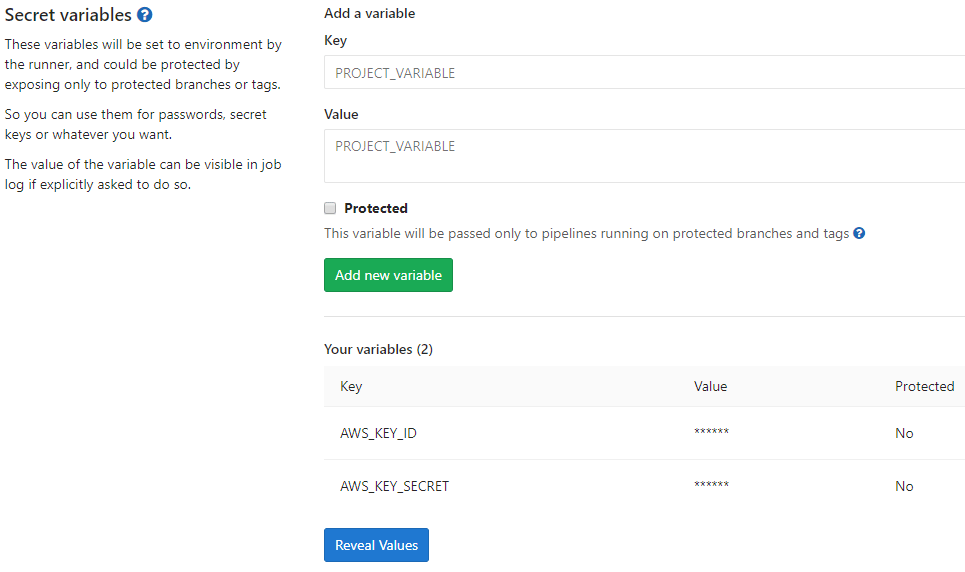DevOps and Game Dev with GitLab CI/CD
With advances in WebGL and WebSockets, browsers are extremely viable as game development platforms without the use of plugins like Adobe Flash. Furthermore, by using GitLab and AWS, single game developers, as well as game dev teams, can easily host browser-based games online.
In this tutorial, we'll focus on DevOps, as well as testing and hosting games with Continuous Integration/Deployment methods using GitLab CI/CD. We assume you are familiar with GitLab, JavaScript, and the basics of game development.
The game
Our demo game consists of a simple spaceship traveling in space that shoots by clicking the mouse in a given direction.
Creating a strong CI/CD pipeline at the beginning of developing another game, Dark Nova, was essential for the fast pace the team worked at. This tutorial will build upon my previous introductory article and go through the following steps:
- Using code from the previous article to start with a bare-bones Phaser game built by a gulp file
- Adding and running unit tests
- Creating a
Weaponclass that can be triggered to spawn aBulletin a given direction - Adding a
Playerclass that uses this weapon and moves around the screen - Adding the sprites we will use for the
PlayerandWeapon - Testing and deploying with Continuous Integration and Continuous Deployment methods
By the end, we'll have the core of a playable game
that's tested and deployed on every push to the master branch of the codebase.
This will also provide
boilerplate code for starting a browser-based game with the following components:
- Written in TypeScript and PhaserJs
- Building, running, and testing with Gulp
- Unit tests with Chai and Mocha
- CI/CD with GitLab
- Hosting the codebase on GitLab.com
- Hosting the game on AWS
- Deploying to AWS
Requirements and setup
Please refer to my previous article DevOps and Game Dev to learn the foundational
development tools, running a Hello World-like game, and building this game using GitLab
CI/CD from every new push to master. The master branch for this game's repository
contains a completed version with all configurations. If you would like to follow along
with this article, you can clone and work from the devops-article branch:
git clone git@gitlab.com:blitzgren/gitlab-game-demo.git
git checkout devops-articleNext, we'll create a small subset of tests that exemplify most of the states I expect
this Weapon class to go through. To get started, create a folder called lib/tests
and add the following code to a new file weaponTests.ts:
import { expect } from 'chai';
import { Weapon, BulletFactory } from '../lib/weapon';
describe('Weapon', () => {
var subject: Weapon;
var shotsFired: number = 0;
// Mocked bullet factory
var bulletFactory: BulletFactory = <BulletFactory>{
generate: function(px, py, vx, vy, rot) {
shotsFired++;
}
};
var parent: any = { x: 0, y: 0 };
beforeEach(() => {
shotsFired = 0;
subject = new Weapon(bulletFactory, parent, 0.25, 1);
});
it('should shoot if not in cooldown', () => {
subject.trigger(true);
subject.update(0.1);
expect(shotsFired).to.equal(1);
});
it('should not shoot during cooldown', () => {
subject.trigger(true);
subject.update(0.1);
subject.update(0.1);
expect(shotsFired).to.equal(1);
});
it('should shoot after cooldown ends', () => {
subject.trigger(true);
subject.update(0.1);
subject.update(0.3); // longer than timeout
expect(shotsFired).to.equal(2);
});
it('should not shoot if not triggered', () => {
subject.update(0.1);
subject.update(0.1);
expect(shotsFired).to.equal(0);
});
});To build and run these tests using gulp, let's also add the following gulp functions
to the existing gulpfile.js file:
gulp.task('build-test', function () {
return gulp.src('src/tests/**/*.ts', { read: false })
.pipe(tap(function (file) {
// replace file contents with browserify's bundle stream
file.contents = browserify(file.path, { debug: true })
.plugin(tsify, { project: "./tsconfig.test.json" })
.bundle();
}))
.pipe(buffer())
.pipe(sourcemaps.init({loadMaps: true}) )
.pipe(gulp.dest('built/tests'));
});
gulp.task('run-test', function() {
gulp.src(['./built/tests/**/*.ts']).pipe(mocha());
});We will start implementing the first part of our game and get these Weapon tests to pass.
The Weapon class will expose a method to trigger the generation of a bullet at a given
direction and speed. Later we will implement a Player class that ties together the user input
to trigger the weapon. In the src/lib folder create a weapon.ts file. We'll add two classes
to it: Weapon and BulletFactory which will encapsulate Phaser's sprite and
group objects, and the logic specific to our game.
export class Weapon {
private isTriggered: boolean = false;
private currentTimer: number = 0;
constructor(private bulletFactory: BulletFactory, private parent: Phaser.Sprite, private cooldown: number, private bulletSpeed: number) {
}
public trigger(on: boolean): void {
this.isTriggered = on;
}
public update(delta: number): void {
this.currentTimer -= delta;
if (this.isTriggered && this.currentTimer <= 0) {
this.shoot();
}
}
private shoot(): void {
// Reset timer
this.currentTimer = this.cooldown;
// Get velocity direction from player rotation
var parentRotation = this.parent.rotation + Math.PI / 2;
var velx = Math.cos(parentRotation);
var vely = Math.sin(parentRotation);
// Apply a small forward offset so bullet shoots from head of ship instead of the middle
var posx = this.parent.x - velx * 10
var posy = this.parent.y - vely * 10;
this.bulletFactory.generate(posx, posy, -velx * this.bulletSpeed, -vely * this.bulletSpeed, this.parent.rotation);
}
}
export class BulletFactory {
constructor(private bullets: Phaser.Group, private poolSize: number) {
// Set all the defaults for this BulletFactory's bullet object
this.bullets.enableBody = true;
this.bullets.physicsBodyType = Phaser.Physics.ARCADE;
this.bullets.createMultiple(30, 'bullet');
this.bullets.setAll('anchor.x', 0.5);
this.bullets.setAll('anchor.y', 0.5);
this.bullets.setAll('outOfBoundsKill', true);
this.bullets.setAll('checkWorldBounds', true);
}
public generate(posx: number, posy: number, velx: number, vely: number, rot: number): Phaser.Sprite {
// Pull a bullet from Phaser's Group pool
var bullet = this.bullets.getFirstExists(false);
// Set the few unique properties about this bullet: rotation, position, and velocity
if (bullet) {
bullet.reset(posx, posy);
bullet.rotation = rot;
bullet.body.velocity.x = velx;
bullet.body.velocity.y = vely;
}
return bullet;
}
}Lastly, we'll redo our entry point, game.ts, to tie together both Player and Weapon objects
as well as add them to the update loop. Here is what the updated game.ts file looks like:
import { Player } from "./player";
import { Weapon, BulletFactory } from "./weapon";
window.onload = function() {
var game = new Phaser.Game(800, 600, Phaser.AUTO, 'gameCanvas', { preload: preload, create: create, update: update });
var player: Player;
var weapon: Weapon;
// Import all assets prior to loading the game
function preload () {
game.load.image('player', 'assets/player.png');
game.load.image('bullet', 'assets/bullet.png');
}
// Create all entities in the game, after Phaser loads
function create () {
// Create and position the player
var playerSprite = game.add.sprite(400, 550, 'player');
playerSprite.anchor.setTo(0.5);
player = new Player(game.input, playerSprite, 150);
var bulletFactory = new BulletFactory(game.add.group(), 30);
weapon = new Weapon(bulletFactory, player.sprite, 0.25, 1000);
player.loadWeapon(weapon);
}
// This function is called once every tick, default is 60fps
function update() {
var deltaSeconds = game.time.elapsedMS / 1000; // convert to seconds
player.update(deltaSeconds);
weapon.update(deltaSeconds);
}
}Run gulp serve and you can run around and shoot. Wonderful! Let's update our CI
pipeline to include running the tests along with the existing build job.
Continuous Integration
To ensure our changes don't break the build and all tests still pass, we use
Continuous Integration (CI) to run these checks automatically for every push.
Read through this article to understand Continuous Integration, Continuous Delivery, and Continuous Deployment,
and how these methods are leveraged by GitLab.
From the last tutorial we already have a .gitlab-ci.yml file set up for building our app from
every push. We need to set up a new CI job for testing, which GitLab CI/CD will run after the build job using our generated artifacts from gulp.
Please read through the documentation on CI/CD configuration file to explore its contents and adjust it to your needs.
Build your game with GitLab CI/CD
We need to update our build job to ensure tests get run as well. Add gulp build-test
to the end of the script array for the existing build job. After these commands run,
we know we will need to access everything in the built folder, given by GitLab CI/CD's artifacts.
We'll also cache node_modules to avoid having to do a full re-pull of those dependencies:
just pack them up in the cache. Here is the full build job:
build:
stage: build
script:
- npm i gulp -g
- npm i
- gulp
- gulp build-test
cache:
policy: push
paths:
- node_modules
artifacts:
paths:
- builtTest your game with GitLab CI/CD
For testing locally, we simply run gulp run-tests, which requires gulp to be installed
globally like in the build job. We pull node_modules from the cache, so the npm i
command won't have to do much. In preparation for deployment, we know we will still need
the built folder in the artifacts, which will be brought over as default behavior from
the previous job. Lastly, by convention, we let GitLab CI/CD know this needs to be run after
the build job by giving it a test stage.
Following the YAML structure, the test job should look like this:
test:
stage: test
script:
- npm i gulp -g
- npm i
- gulp run-test
cache:
policy: push
paths:
- node_modules/
artifacts:
paths:
- built/We have added unit tests for a Weapon class that shoots on a specified interval.
The Player class implements Weapon along with the ability to move around and shoot. Also,
we've added test artifacts and a test stage to our GitLab CI/CD pipeline using .gitlab-ci.yml,
allowing us to run our tests by every push.
Our entire .gitlab-ci.yml file should now look like this:
image: node:10
build:
stage: build
script:
- npm i gulp -g
- npm i
- gulp
- gulp build-test
cache:
policy: push
paths:
- node_modules/
artifacts:
paths:
- built/
test:
stage: test
script:
- npm i gulp -g
- npm i
- gulp run-test
cache:
policy: pull
paths:
- node_modules/
artifacts:
paths:
- built/Run your CI/CD pipeline
That's it! Add all your new files, commit, and push. For a reference of what our repository should look like at this point, please refer to the final commit related to this article on my sample repository. By applying both build and test stages, GitLab will run them sequentially at every push to our repository. If all goes well you'll end up with a green check mark on each job for the pipeline:
You can confirm that the tests passed by clicking on the test job to enter the full build logs.
Scroll to the bottom and observe, in all its passing glory:
$ gulp run-test
[18:37:24] Using gulpfile /builds/blitzgren/gitlab-game-demo/gulpfile.js
[18:37:24] Starting 'run-test'...
[18:37:24] Finished 'run-test' after 21 ms
Weapon
✓ should shoot if not in cooldown
✓ should not shoot during cooldown
✓ should shoot after cooldown ends
✓ should not shoot if not triggered
4 passing (18ms)
Uploading artifacts...
built/: found 17 matching files
Uploading artifacts to coordinator... ok id=17095874 responseStatus=201 Created token=aaaaaaaa Job succeededContinuous Deployment
We have our codebase built and tested on every push. To complete the full pipeline with Continuous Deployment,
let's set up free web hosting with AWS S3 and a job through which our build artifacts get
deployed. GitLab also has a free static site hosting service we can use, GitLab Pages,
however Dark Nova specifically uses other AWS tools that necessitates using AWS S3.
Read through this article that describes deploying to both S3 and GitLab Pages
and further delves into the principles of GitLab CI/CD than discussed in this article.
Set up S3 Bucket
- Log into your AWS account and go to S3
- Click the Create Bucket link at the top
- Enter a name of your choosing and click next
- Keep the default Properties and click next
- Click the Manage group permissions and allow Read for the Everyone group, click next
- Create the bucket, and select it in your S3 bucket list
- On the right side, click Properties and enable the Static website hosting category
- Update the radio button to the Use this bucket to host a website selection. Fill in
index.htmlanderror.htmlrespectively
Set up AWS Secrets
We need to be able to deploy to AWS with our AWS account credentials, but we certainly don't want to put secrets into source code. Luckily GitLab provides a solution for this with Variables. This can get complicated due to IAM management. As a best practice, you shouldn't use root security credentials. Proper IAM credential management is beyond the scope of this article, but AWS will remind you that using root credentials is unadvised and against their best practices, as they should. Feel free to follow best practices and use a custom IAM user's credentials, which will be the same two credentials (Key ID and Secret). It's a good idea to fully understand IAM Best Practices in AWS. We need to add these credentials to GitLab:
-
Log into your AWS account and go to the Security Credentials page
-
Click the Access Keys section and Create New Access Key. Create the key and keep the ID and secret around, you'll need them later
-
Go to your GitLab project, click Settings > CI/CD on the left sidebar
-
Expand the Variables section
-
Add a key named
AWS_KEY_IDand copy the key ID from Step 2 into the Value field -
Add a key named
AWS_KEY_SECRETand copy the key secret from Step 2 into the Value field
Deploy your game with GitLab CI/CD
To deploy our build artifacts, we need to install the AWS CLI on
the shared runner. The shared runner also needs to be able to authenticate with your AWS
account to deploy the artifacts. By convention, AWS CLI will look for AWS_ACCESS_KEY_ID
and AWS_SECRET_ACCESS_KEY. GitLab CI/CD gives us a way to pass the variables we
set up in the prior section using the variables portion of the deploy job. At the end,
we add directives to ensure deployment only happens on pushes to master. This way, every
single branch still runs through CI, and only merging (or committing directly) to master will
trigger the deploy job of our pipeline. Put these together to get the following:
deploy:
stage: deploy
variables:
AWS_ACCESS_KEY_ID: "$AWS_KEY_ID"
AWS_SECRET_ACCESS_KEY: "$AWS_KEY_SECRET"
script:
- apt-get update
- apt-get install -y python3-dev python3-pip
- easy_install3 -U pip
- pip3 install --upgrade awscli
- aws s3 sync ./built s3://gitlab-game-demo --region "us-east-1" --grants read=uri=http://acs.amazonaws.com/groups/global/AllUsers --cache-control "no-cache, no-store, must-revalidate" --delete
only:
- masterBe sure to update the region and S3 URL in that last script command to fit your setup.
Our final configuration file .gitlab-ci.yml looks like:
image: node:10
build:
stage: build
script:
- npm i gulp -g
- npm i
- gulp
- gulp build-test
cache:
policy: push
paths:
- node_modules/
artifacts:
paths:
- built/
test:
stage: test
script:
- npm i gulp -g
- gulp run-test
cache:
policy: pull
paths:
- node_modules/
artifacts:
paths:
- built/
deploy:
stage: deploy
variables:
AWS_ACCESS_KEY_ID: "$AWS_KEY_ID"
AWS_SECRET_ACCESS_KEY: "$AWS_KEY_SECRET"
script:
- apt-get update
- apt-get install -y python3-dev python3-pip
- easy_install3 -U pip
- pip3 install --upgrade awscli
- aws s3 sync ./built s3://gitlab-game-demo --region "us-east-1" --grants read=uri=http://acs.amazonaws.com/groups/global/AllUsers --cache-control "no-cache, no-store, must-revalidate" --delete
only:
- masterConclusion
Within the demo repository you can also find a handful of boilerplate code to get TypeScript, Mocha, Gulp and Phaser all playing together nicely with GitLab CI/CD, which is the result of lessons learned while making Dark Nova. Using a combination of free and open source software, we have a full CI/CD pipeline, a game foundation, and unit tests, all running and deployed at every push to master - with shockingly little code. Errors can be easily debugged through GitLab build logs, and within minutes of a successful commit, you can see the changes live on your game.
Setting up Continuous Integration and Continuous Deployment from the start with Dark Nova enables rapid but stable development. We can easily test changes in a separate environment, or multiple environments if needed. Balancing and updating a multiplayer game can be ongoing and tedious, but having faith in a stable deployment with GitLab CI/CD allows a lot of breathing room in quickly getting changes to players.
Further settings
Here are some ideas to further investigate that can speed up or improve your pipeline:
- Yarn instead of npm
- Set up a custom Docker image that can pre-load dependencies and tools (like AWS CLI)
- Forward a custom domain to your game's S3 static website
- Combine jobs if you find it unnecessary for a small project
- Avoid the queues and set up your own custom GitLab CI/CD runner


